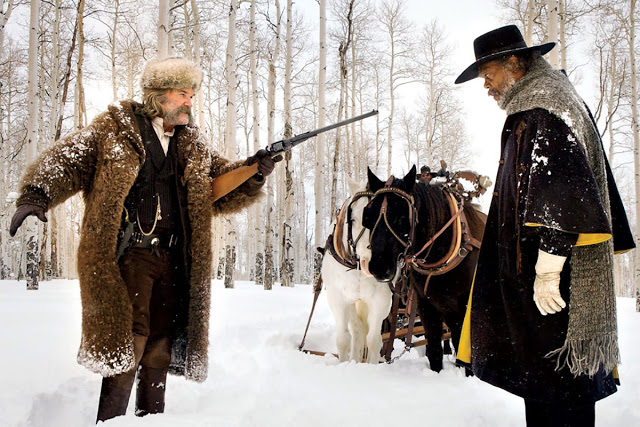The Hateful Eight: Fun and Fury in the Old West
The Hateful Eight is silly, self-indulgent, overlong, and obscenely ostentatious. It is also funny, bracing, suspenseful, and supremely entertaining. It is, in other words, a film by Quentin Tarantino, cinema’s poet laureate of grisly violence and savory dialogue. This is the kind of happily ridiculous movie where the no-good woman spends the entire second half with her face covered in blood, and where the manly men seem to have engaged in a mustache-growing contest. As a writerly work of fiction, The Hateful Eight is difficult to take seriously. As a thrilling piece of pulp art, it is impossible to dismiss.
That is especially true for cinephiles. The world’s most celebrated former video-store clerk, Tarantino can be exasperating in his nerdy superiority, his compulsion to constantly remind you of the scope of his encyclopedic knowledge of film’s annals. But he possesses real love for the movies, and The Hateful Eight—which, as the opening title card gratuitously announces, is the eighth picture of his career—is his most pronounced valentine to the form yet. Shot in the fossilized format of 65-millimeter film, its languorous opening scenes—featuring painterly images of a stagecoach striving against the snow of a Wyoming blizzard (shooting took place in Colorado), and of a cloaked man with his head bowed against the cold—beautifully capture the visual majesty of the medium. (Most theaters with digital projectors are showing The Hateful Eight in a slightly truncated version, but a “traveling roadshow” is exhibiting the film in select areas in 70mm, complete with an overture, intermission, and a few extended scenes.) Tarantino’s screenplays may go overboard with their insouciant humor, but in these striking early scenes (shot by Oscar-winning cinematographer Robert Richardson), he makes clear that his craft is not a joke. To him, movies still matter. Read More

